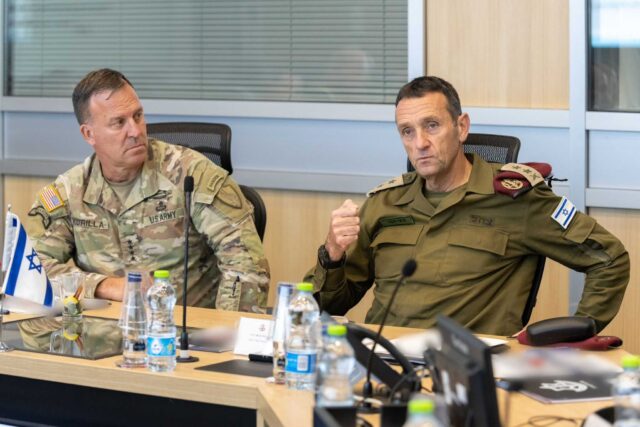
Four years ago, as part of the 2016 Trump administration’s adjustments to the Unified Command Plan (UCP), Israel was officially transferred from US European Command (USEUCOM) to US Central Command (USCENTCOM). This meant Israel was expected to engage in security cooperation (e.g., exercises, military sales, operational planning) with US regional allies and partners, also in USCENTCOM – specifically, with moderate Arab states. The Abraham Accords, signed in 2020, were a vital precursor to this move and a harbinger of future Arab-Israel collaboration.
Israel’s transition to USCENTCOM and the subsequent trajectory toward greater operational integration represents more than a mere bureaucratic change. It has signaled a realignment of strategic relationships and expectations, opening the door for multinational exercises, operational synergies, and a plethora of future collaborations between Israel and the moderate Arab states, all under US aegis.
At the time, the focus was on foundational benefits: military sales, joint training and exercises, the assignment of exchange and liaison officers, and crucially, a single operational theater that improved communication and coordination – especially in air and missile defense. Israel’s entrance into the USCENTCOM area of responsibility (AOR) allowed it to collaborate more easily with Arab militaries that are also US partners.
Those fundamentals remain in place today, but Israel’s role within USCENTCOM has matured. It is no longer only about capability building and interoperability. It is now about combined operations.
This shift is evident in the maritime and integrated air and missile defense domains. The International Maritime Exercise (IMX) series, hosted by the US Navy’s Fifth Fleet in Bahrain, now features Israeli naval assets alongside Gulf Arab partners. The exercise covers a range of operational scenarios, including mine countermeasures, integration of unmanned systems and artificial intelligence, vessel defense, search and rescue, mass casualty response, and counter-terrorism operations. The Israel Navy’s 3rd Flotilla (missile ships), the 915th Patrol Boats Squadron, and the Underwater Missions Unit (YALTAM) participated in the exercise. This is not symbolic; it is operational. Israel’s presence in the Arabian Gulf and Red Sea has become a practical component of regional maritime security, and its naval forces now operate under a shared understanding with other USCENTCOM partners on deconfliction, tactical communication, and shared threats.
No figure better symbolizes this new era of Israel-USCENTCOM cooperation than General Michael “Gorilla” Kurilla, who assumed command of USCENTCOM in April 2022. Since taking command, Gen. Kurilla has visited Israel five times on official visits since the October 7, 2023 attack, an extraordinary frequency for a combatant commander. He has also visited at least four other times on short notice following the Iranian attacks or during other crises. His presence on the ground reflects Israel’s centrality to USCENTCOM planning and Kurilla’s commitment to building trust among the region’s stakeholders.
Houthi Attacks
Ongoing since October 2023, the Yemeni Houthis have launched more than 200 ballistic missiles and 170 drones toward Israel. These attacks have repeatedly targeted Israeli territory, starting with the Eilat region and now, more often in Israel’s center, including areas near Ben Gurion Airport and Israel’s major seaports. In response, Israel has intercepted the vast majority of these threats using its own air defense systems, sometimes with assistance from US Navy ships operating in the Red Sea, such as the USS Carney and others, which have shot down missiles and drones heading toward Israel.
USCENTCOM partners – including Saudi Arabia, the United Arab Emirates (UAE), and Bahrain – have reportedly increased intelligence sharing and regional airspace coordination with USCENTCOM. This level of cooperation, including the sharing of radar data and early warning information, represents a significant and unprecedented shift in regional defense dynamics, making operational realities that would have been unthinkable a decade ago.
Starting on the evening of April 13, 2024, and continuing into the early hours of April 14, 2024. Iran attacked Israel with more than 170 drones, 30 plus cruise missiles, and 120 plus ballistic missiles. The defense of Israel was coordinated, integrated, and multinational. USCENTCOM partners like Jordan and US global partners the UK and France participated directly in the defense of Israeli airspace. US forces in the region (including those at Al-Udeid Air Base in Qatar and US Navy ships) participated in intercepting threats. The second Iranian attack on October 1, 2024, demonstrated that the previous event was not an anomaly but a new operating norm.
Each visit has deepened bilateral cooperation. During his March 2023 visit, Gen. Kurilla observed IDF exercises involving long-range strike scenarios and joint missile defense simulations. In July 2023, he met with defense officials to discuss operational responses to Iranian aggression in Syria and the Red Sea. His January 2024 visit came amid escalating Houthi threats and involved high-level war gaming and strategic coordination sessions with Israeli military planners. These visits signal to allies and adversaries alike that the Washington-Jerusalem relationship is operationally active and strategically strong.
Support in Gaza
The US has provided extensive intelligence and operational support to Israel during IDF operations in the Gaza Strip, including signals intelligence, precision targeting assistance, and persistent ISR (intelligence, surveillance, and reconnaissance) coverage through American drones and surveillance aircraft, which have complemented Israel’s own robust capabilities; this support has also included significant arms transfers, naval and aerial deployments, and cooperation on special operations planning.
Lebanon
With Operation “Opening Blow” – Israel’s beeper and radio covert action against Hezbollah – Israel attacked Hezbollah operatives and the command and control system they relied upon. Following the attack, Israel continued its campaign with airstrikes and targeted assassinations, with Hezbollah’s Secretary-General Hassan Nasrallah killed by an Israel air strike on September 27, 2024. These activities weakened Hezbollah to such an extent that an opportunity emerged for the new Lebanese government to attempt to reassert its authority over the country.
Israel’s sustained military campaign, combined with US diplomatic leverage and substantial aid to the Lebanese Armed Forces (LAF), is designed to create conditions under which the Lebanese state can reassert control, particularly in the south. The Times of Israel has published a recent article detailing how Israeli intelligence – delivered to the Lebanese authorities via the United States – has helped locate remaining Hezbollah caches and posts in southern Lebanon. The US and Israel are closely coordinating both their military and diplomatic activities, with joint intelligence sharing, a shared approach to monitoring ceasefire violations, and a mutual commitment to limiting Iranian influence and ensuring Hezbollah’s disarmament or withdrawal. The US-led monitoring committee, which includes France and other partners, provides a framework for managing disputes and supporting Israeli actions against Hezbollah resupply efforts, while continued American support for Lebanon’s reconstruction and military is explicitly tied to progress in reducing Hezbollah’s role.
While US forces have not operated in combat roles alongside the IDF, the depth of coordination – especially in logistics, ISR, and strategic messaging – reflects a shift from traditional strategic alignment toward a more integrated operational partnership.
More Regional Partners
Washington increasingly expects close allies to support multinational coalitions. The “expeditionary expectation” is real. Israel, while still primarily focused on territorial defense, is edging toward this paradigm. In recent months, there have been credible reports that Gulf states, particularly the United Arab Emirates, are expanding security cooperation with Israel in response to the threat of Houthi missile and drone attacks. Citing satellite imagery, The Times of Israel reported that the imagery showed “two Barak launchers and an Elta ELM 2084 [Israel] radar near the al-Dhafra airbase, south of the UAE capital Abu Dhabi.” Also, open-source intelligence has confirmed the deployment of an ELM-2084 in northeastern Somalia – to enhance early warning and tracking of aerial threats from the Yemeni Houthis. This cooperation signals Israel’s willingness to support regional partners against shared threats.
Israel’s contributions to cyber defense, intelligence fusion, and special operations liaison roles have also expanded. US and Israeli cyber units have jointly monitored Iranian-linked threat groups, especially during periods of escalated regional tensions. Special forces from both countries have conducted joint training in desert and urban environments, simulating scenarios likely to arise in future contingencies.
Israel’s cooperation with other regional players will likely grow. Steve Witkoff, the US Special Envoy to the Middle East, has publicly predicted that once the Gaza War is over, the Abraham Accords are poised for imminent expansion. Speaking at multiple events in May 2025, including Israeli Independence Day celebrations in Washington, Witkoff stated, “We think [we] will have some, or a lot of announcements, very, very shortly, which we hope will yield great progress by next year.” He emphasized that these developments could lead to significant diplomatic breakthroughs and further normalization between Israel and additional states. His remarks are echoed by other US officials, including Secretary of State Marco Rubio, who testified before Congress that he expects “a number of more countries that are willing to join that alliance,” potentially by the end of the year.
While no countries have been officially named, diplomatic analysis points to several likely candidates, all of which fall under USCENTCOM’s auspices. Saudi Arabia remains a key but complicated target, with its position influenced by the ongoing conflict in Gaza. Azerbaijan and Kazakhstan have been identified as promising prospects due to their strong existing ties with Israel and interest in expanding economic and security cooperation. Azerbaijan has held direct discussions with Israeli officials, while Kazakhstan seeks to use the Accords to reduce its reliance on Russia and China. Syria has also been mentioned as an Abraham Accords candidate directly by President Trump when he announced the lifting of US sanctions on Damascus.
From Integration to Operational Partner
The transformation of Israel’s role in USCENTCOM from integration to operational partnership is ongoing, but its trajectory is clear. What began as a bureaucratic realignment has developed into joint exercises, real-time threat responses, and deepening military ties. As a major non-NATO ally with one of the region’s most capable and battle-tested militaries, Israel is increasingly seen by Arab states as a pillar of regional security rather than a pariah. Looking ahead, Israel’s participation in USCENTCOM may expand to include multinational deployments beyond the Middle East as the US seeks to share the burden of global security. By partnering with USCENTCOM, Israel is building upon a relationship that promotes interoperability and operational cooperation, builds trust among regional partners, and, when necessary, avoids the political costs of normalization while cooperation continues and deepens through informal channels.
Cdr. David Levy, USN (ret.) is a senior research fellow at the Begin-Sadat Center for Strategic Studies, Bar-Ilan University and a former US diplomat.

